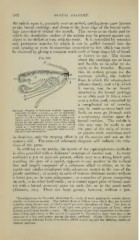Page 332 - My FlipBook
P. 332
342 DENTAL ANATOMY.
the radula upon it, generally over an arched, cartilaginous mass known
as the buccal cartilage, and down to the front edge of the buccal carti-
lage immediately behind the mouth. This serves as an elastic pad by
which the denticulate surface of the radula may be pressed against any
object to be drilled or torn with the teeth. It is controlled by retractor
and protractor muscles, by which it can be pulled forward into the
oral opening or even be somewhat protruded—a fact which can easily
be observed by giving a common wood-snail or large slug a bit of bread
or lettuce to eat. The tissues
about the cartilage are so loose
and flexible as to offer no ob-
stacle to the transfer. Beyond
this, in certain groups (as the
common whelk), the radular
floor, to which the odontophore
.
adheres closely, and with which
it moves, may be so loosely
attached to the buccal cartilage
as to slide over it like a towel
over a roller, and, controlled by
a complicated set of muscles,
niay be made to move back and
, ,
„
,
.
,
.
Sectional Diagram of jNIolhiscan Radular Apparatus, n '\ i i • , i
,
vertically divided: 0, mouth; ?H, jaw or mandible; lortU, Or CVCU gO tliroUgll Wltll
.•
/.lower lip; •
,
iluizzle; ff.Ruilet; //teeth set on the odontophore, tllC
which rests on thf^ muscular radular floor, sup- Knr>P'il nntliinn TIip virlnln in
X lie ItUlUUt HI
ported by the muscular buccal mass, from which »Jll<-<-'ti LLlblllUll.
extend backward retractor muscles ik, k,). and in tllis Way UiaV be made tO act
which is (n imbedded the buccal cartilaKe; .v, the , " r> ,1 . • /?
opening of the radular sac: p, papilla wliich secretes tUC part Ot the Strip 01 Cmery
the teeth and odontophore.
^^ ^^^^^^.^^ ^j^^j^ SOmetimeS UScd
in dentistry, only the rasping effect is on the convex and not on the
concave side. The annexed schematic diagram will indicate the rela-
tions of the parts.
In addition to the radula, the mouth of the cephalophorous mollusks
is often provided with a chitinous' armature of another sort. In many
mollusks a jaw or jaws are present, which may be a strong black pair,
recalling the jaws of a parrot, opposed to one another in the vertical
line and largely composed of a substance allied to chitin, as in the
squids and cuttles (reinforced with calcareous matter in the case of the
pearly nautilus) ; or merely an arch of delicate chitiuous matter without
a lower jaw, as in some ])ulmonates ; or a number of pieces composing
an arch, as in other land-snails ; or a central upper piece of horny mat-
ter with a lateral accessory piece on each side, as in the pond-snails
{Limncea, etc.). There are large groups, however, without a jaw.
' Tnvestifration.s by Tro.scliel show tliat tlie teeth of most gastropods consist almost
wholly of chitinous matter. The radular Hoor or ribbon upon which they are inserted
contains abont 04 per cent, of chitin and (5 percent, phosphate of lime. The jaws of
JJoliiim and Ilrlir pnnialia show a 1 or 2 per cent, greater proportion of lime ; other
helices would show hardly a trace. The references of previous naturalists to the pres-
ence of iron and silicon in the radula is supposed by Troschel to have been due to the
presence of a few sand-grains among the teeth analyzed. Slight diflerences doubtless
exist between difi'erent kinds of mollusks, which would explain the differing results of
various analvses.


